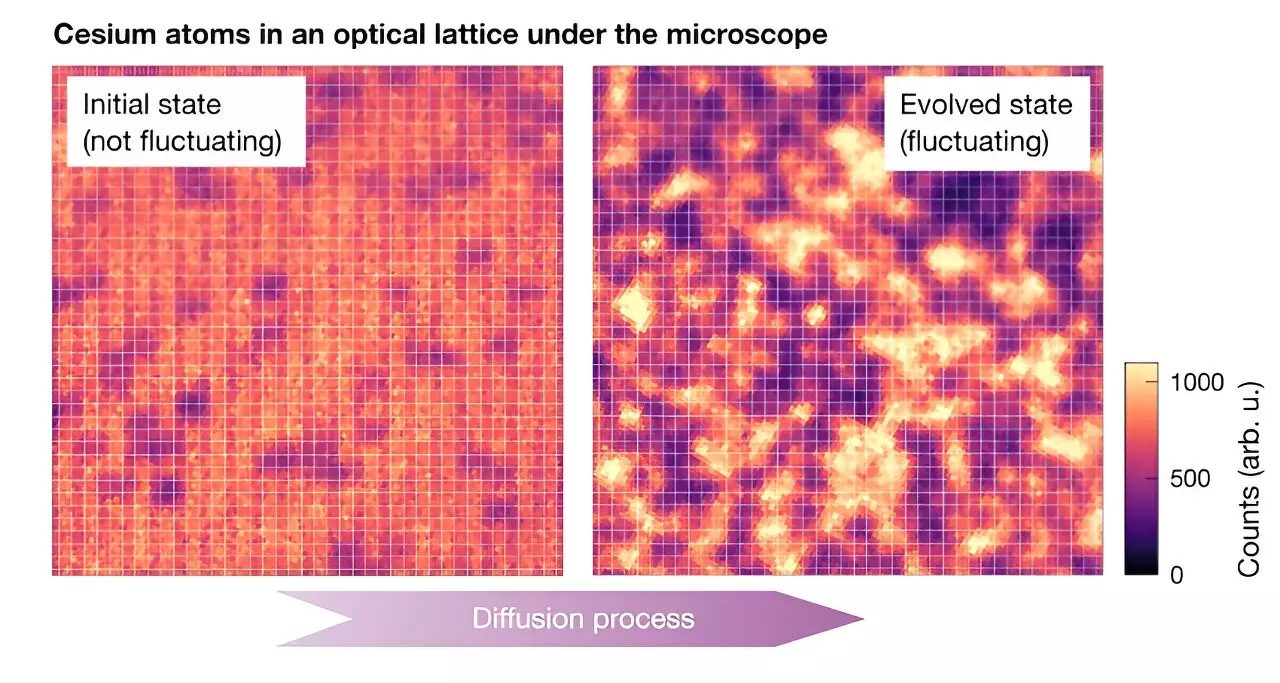In the realm of quantum physics, the complexity of large-scale systems poses significant challenges to researchers aiming to predict their behavior. Scientists from various esteemed institutions, including Ludwig-Maximilians-Universität, the Max-Planck-Institut für Quantenoptik, and the University of Massachusetts, have recently shed light on this issue through innovative research published in *Nature Physics*. Their groundbreaking study investigates the equilibrium fluctuations in expansive quantum systems, utilizing state-of-the-art quantum gas microscopy to unravel intricate particle interactions in ultracold environments.
The instrument at the heart of this research is the quantum gas microscope, an experimental technology enabling precise imaging and manipulation of individual particles within ultracold atomic gases. Co-author Julian Wienand elaborates on the intricacies of managing a significant number of particles in a confined space, likening the process to forecasting the future behavior of a multitude of particles based on their physical interactions. Traditional simulation methods can falter under the weight of computational demands; hence, the research team has employed established concepts from hydrodynamics as a more feasible approach for describing particle dynamics.
The concept of Fluctuating Hydrodynamics (FHD) emerges as a solution for physicists grappling with the randomness inherent in quantum particles as they aggregate into larger systems. When particle interactions are chaotic, a state of local thermal equilibrium can be postulated, allowing scientists to apply hydrodynamic principles to describe these particle systems as continuous fields governed by differential equations. This theoretical framework acknowledges that microscopic fluctuations—the erratic movements of fast-moving particles—result in variations that can be modeled as stochastic processes, akin to white noise. By incorporating these perturbations into the governing equations, researchers can effectively simulate not just average behaviors but the fluctuations present in these systems.
Quantum systems inherently differ from classical models, chiefly due to phenomena like entanglement, which complicate traditional calculations. The research conducted by Wienand and his colleagues employed a cesium-133 (Cesium) quantum gas microscope to observe a profound quantum many-body system formed by manipulating ultracold cesium atoms arranged in an optical lattice. The lattice structure, maintained by laser light, facilitated a unique experimental setup to monitor particle interactions closely. The microscopic technique utilized allowed for a resolution where researchers could distinguish occupied and unoccupied sites, thus providing invaluable statistical insights into particle number fluctuations.
The experimental process began with the atoms being excited within predefined sites, creating an orderly arrangement. Subsequently, the research team abruptly altered the depth of the lattice, triggering a diffusion process as atoms moved and interacted, thereby entering a thermalization stage. As fluctuations evolved throughout this process, the researchers meticulously tracked these changes over time, comparing observed behaviors against theoretical predictions rooted in FHD. The results were promising, as they confirmed that the dynamics of the system could indeed be described using the FHD model, enabling the estimation of critical quantities such as the diffusion constant.
The implication of these findings is profound; they illustrate how entrenched theories in classical physics can extend their relevance into the quantum realm. The researchers indicated that even when a system’s intricate quantum mechanics complicate its micro-state behavior, the emergent macroscopic dynamics can exhibit simplicity, effectively modeled through diffusion principles. A particularly interesting aspect observed is that the diffusion constant, a characteristic of equilibrium benchmarks, can still be measured in systems that are out of equilibrium, establishing a new interplay between these two states.
The study encourages a generation of inquiries about fluctuating behaviors in non-thermalizing systems and the applicability of FHD to other exotic scenarios. The prospect of adapting FHD to describe more intricate observables, including higher moments such as skewness and kurtosis, marks a promising frontier in quantum research. The team is poised to dive deeper into these aspects in upcoming studies, potentially unlocking further complexities of quantum many-body dynamics.
By bridging classical hydrodynamics with the chaotic world of quantum mechanics, the research by Wienand and his peers lays the foundation for a richer understanding of quantum systems. Their work not only showcases the adaptability of established theories but also opens avenues for innovative approaches to studying the dynamics of particles at the quantum level. This alignment of classical and quantum theories might one day allow for reliable predictions about the behavior of complex systems, enhancing our overall comprehension of the quantum universe.

